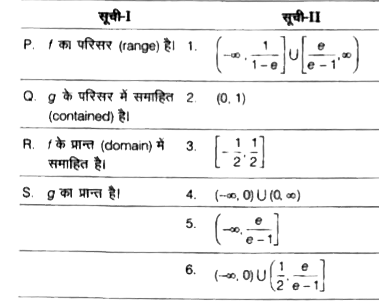माना कि M=[sin2θ−1−sin2θ1+cos2θcos4θ]=αI+βM−1 जहाँ α=α(θ) और β=β(θ) वास्तविक संख्याएँ हैं, और I एक 2×2 तत्समक-आव्यूह है। यदि समुच्चय {α(θ:θ∈[0,2π]} का निम्नतम α* है और समुच्चय {β(θ):θ∈[0,2π]} का निम्नतम β* है, तो α*+β* का मान है
−1716
−3116
−3716
−2916
The correct Answer is:D
Step by step video, text & image solution for माना कि M=[(sin^(2)theta,-1-sin^2theta),(1+cos^2theta,cos^4theta)]=alphaI+betaM^(-1) जहाँ alpha = alpha (theta) और beta=beta(theta) वास्तविक संख्याएँ हैं, और I एक 2xx2 तत्समक-आव्यूह है। यदि समुच्चय {alpha(theta:thetain[0,2pi]} का निम्नतम alpha^("*") है और समुच्चय {beta(theta):theta in [0,2pi]} का निम्नतम beta^("*") है, तो alpha^("*")+beta^("*") का मान है by Maths experts to help you in doubts & scoring excellent marks in Class 12 exams.
Updated on:21/07/2023Topper's Solved these Questions
- JEE ADVANCED सॉल्वड पेपर 2019BOOK - JEE Main & Advanced (Hindi Medium)CHAPTER - JEE ADVANCED सॉल्वड पेपर 2019EXERCISE - पेपर 1 खण्ड 2
8 Videos
- JEE ADVANCED सॉल्वड पेपर 2019BOOK - JEE Main & Advanced (Hindi Medium)CHAPTER - JEE ADVANCED सॉल्वड पेपर 2019EXERCISE - पेपर 1 खण्ड 3
6 Videos
- JEE ADVANCED पेपर - 2 (2021)BOOK - JEE Main & Advanced (Hindi Medium)CHAPTER - JEE ADVANCED पेपर - 2 (2021)EXERCISE - MATHEMATICS (खंड-4)
3 Videos
- JEE ADVANCED सोल्वड पेपर्स 2018 BOOK - JEE Main & Advanced (Hindi Medium)CHAPTER - JEE ADVANCED सोल्वड पेपर्स 2018 EXERCISE - पेपर 2 (खण्ड 3)
4 Videos
Similar Questions
माना कि ⌈ एक वक्र y= f(x) है जो प्रथम चतुर्थांश में है और माना कि बिन्दु (1,0) उस पर स्थित है। माना कि ⌈ के बिन्दु पर खींची गयी स्पर्श रेखा y- अक्ष को Yp पर प्रतिच्छेद करती है। यदि ⌈ के प्रत्येक बिन्दु P के लिए PYp की लम्बाई 1 है, तब निम्न में से कौनसा (से) कथन सही है (है)
View Solutionमाना की S ऐसे 3×3 आव्यूहों का प्रतिदर्श समष्टि है जिनकी प्रविष्टियाँ समुच्चय {0,1} से है। माना की घटनाएँ E1 एवं E2 निम्न है
E1{A∈S:detA=0} और
E2{A∈S:A की प्रविष्टियों का कुल योग 7}है
यदि एक आव्यूह S से यादृच्छिक चुना जाता है, तब सहप्रतिबन्ध प्रायिकता P(E1∣E2) बराबर ...................
View Solutionसमुच्चय {1, 2, 3......, 2000} में से एक संख्या का यादृच्छया चयन किया जाता है। माना चयनित संख्या के 3 या 7 का गुणज होने की प्रायिकता p है। तब 500p का मान ______ है |
View Solutionमाना की E1={x∈R:x≠1औरxx−1>0} और E2={x∈E1sin−1(loge(xx−1)} एक वास्तविक संख्या (real number) है|
(यहाँ प्रतिलोम त्रिकोणमितीय फलां (inverse trignometric function) sin−1x,[−π2,π2] में मान धारण करता है|
माना की फलन: f:E1→R,f(x)=loge(xx−1) के द्वारा परिभाषित है
और फलन f:E2→R,g(x)=sin−1lloge(xx−1) के द्वारा परिभाषित है|

दिए हुए विकल्पों में से सही विकल्प है
View SolutionIf cos alpha+cos beta=a sin alpha+sin beta=balpha-beta=2 theta then (cos3 theta)/(cos theta)=
View SolutionIf cos(θ−α)=a and cos(θ−β)=b then the value of sin2(α−β)+2abcos(α−β)
View SolutionM=[sin4θ−1−sin2θ1+cos2θcos4θ]=αI+βM−1
Where α=α(θ) and β=β(θ) ar real numbers and I is an identity matric of 2×2
if α∗= min of set {α(θ):θ∈[0.2π)}
and β∗= min of set {β(θ):θ∈[0.2π)}
Then value of α∗+β∗ is
View SolutionLet [sin4θ−1−sin2θ1+cos2θcos4θ]=αI+βM−1, where α=(θ) and β=β(θ) are real numbers, and I is then 2×2 identify matrix. If α is the minimum of the set {α(θ):θ∈[0,2π)}andβ is the minimum of the set {β(θ):θ∈[0,2π)}, then the value of α∗+β∗ is
View SolutionThe value of the determinant ∣∣ ∣ ∣∣1sin(α−β)θcos(α−β)θasinαθcosαθa2sin(α−β)θcos(α−β)θ∣∣ ∣ ∣∣ is independent of
View SolutionIf alpha+beta+gamma=2theta Then costheta+cos(theta-alpha)+cos(theta-beta)+cos(theta-gamma) Is equal
View SolutionSupposed that M=[(sin^(2)theta,-1-sin^2theta),(1+cos^2theta,cos^4theta)]=alphaI+betaM^(-1) Where alpha = alpha (theta) And beta=beta(theta) Are real numbers, and I is a 2xx2 Is a matrix If set {alpha(theta:thetain[0,2pi]} Lowest of alpha^("*") Is and set {beta(theta):theta in [0,2pi]} Lowest of beta^("*") If so alpha^("*")+beta^("*") The value of
View SolutionIf cos(θ−α)=a and cos(θ−β)=b then the value of sin2(α−β)+2abcos(α−β)
View SolutionIf sin(θ+α)=aandsin(θ+β)=b,thencos2(α−β)−4abcos(α−β)=
View SolutionIf cos(θ−α)=a and cos(θ−β)=b then the value of sin2(α−β)+2abcos(α−β)
View SolutionIf alpha +beta + gamma = 2theta then costheta+cos(θ−α)+cos(θ−β)+cos(θ−γ)
View Solution
